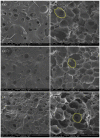Biodegradable Starch/Chitosan Foam via Microwave Assisted Preparation: Morphology and Performance Properties
- PMID: 33172008
- PMCID: PMC7694691
- DOI: 10.3390/polym12112612
Biodegradable Starch/Chitosan Foam via Microwave Assisted Preparation: Morphology and Performance Properties
Erratum in
-
Correction: Zhang et al. Biodegradable Starch/Chitosan Foam via Microwave Assisted Preparation: Morphology and Performance Properties. Polymers 2020, 12, 2612.Polymers (Basel). 2022 Apr 21;14(9):1691. doi: 10.3390/polym14091691. Polymers (Basel). 2022. PMID: 35567099 Free PMC article.
Abstract
The effects of chitosan (CTS) as the reinforcing phase on the properties of potato starch (PS)-based foams were studied in this work. The formic acid solutions of CTS and PS were uniformly mixed in a particular ratio by blending and then placed in a mold made of polytetrafluoroethylene for microwave treatment to form starch foam. The results showed that the molecular weight and concentration of CTS could effectively improve the density and compressive properties of starch-based foams. Furthermore, orthogonal experiments were designed, and the results showed that when the molecular weight of CTS in foams is 4.4 × 105, the mass fraction is 4 wt%, and the mass ratio of CTS-PS is 3/4.2; the compressive strength of foams is the highest at approximately 1.077 mPa. Furthermore, Fourier transform infrared spectroscopy analysis demonstrated the interaction between starch and CTS, which confirmed that the compatibility between CTS and PS is excellent.
Keywords: chitosan; foam; microwave; orthogonal experiments; potato starch.
Conflict of interest statement
There is no conflict of interest among authors.
Figures









Similar articles
-
Preparation and Characterization of Dual-Modified Cassava Starch-Based Biodegradable Foams for Sustainable Packaging Applications.ACS Omega. 2022 Jun 1;7(23):19579-19590. doi: 10.1021/acsomega.2c01292. eCollection 2022 Jun 14. ACS Omega. 2022. PMID: 35722021 Free PMC article.
-
Reactive blending of thermoplastic starch and polyethylene-graft-maleic anhydride with chitosan as compatibilizer.Carbohydr Polym. 2016 Nov 20;153:89-95. doi: 10.1016/j.carbpol.2016.07.091. Epub 2016 Jul 22. Carbohydr Polym. 2016. PMID: 27561475
-
Effect of molecular weight of chitosan degraded by microwave irradiation on lyophilized scaffold for bone tissue engineering applications.J Biomed Mater Res A. 2011 Apr;97(1):66-73. doi: 10.1002/jbm.a.33029. Epub 2011 Feb 11. J Biomed Mater Res A. 2011. PMID: 21319294
-
Novel composite foam made from starch and water hyacinth with beeswax coating for food packaging applications.Int J Biol Macromol. 2020 Dec 15;165(Pt A):1382-1391. doi: 10.1016/j.ijbiomac.2020.10.007. Epub 2020 Oct 8. Int J Biol Macromol. 2020. PMID: 33038400
-
Thermoplastic Starch with Poly(butylene adipate-co-terephthalate) Blends Foamed by Supercritical Carbon Dioxide.Polymers (Basel). 2022 May 11;14(10):1952. doi: 10.3390/polym14101952. Polymers (Basel). 2022. PMID: 35631835 Free PMC article.
Cited by
-
Mechanical Behavior Modelling and Filler Geometry Effect of Glass Filler Reinforced Starch-Epoxy Hybrid Matrix Composites.Materials (Basel). 2021 Nov 2;14(21):6587. doi: 10.3390/ma14216587. Materials (Basel). 2021. PMID: 34772113 Free PMC article.
-
Biopolymers from Natural Resources.Polymers (Basel). 2021 Jul 30;13(15):2532. doi: 10.3390/polym13152532. Polymers (Basel). 2021. PMID: 34372135 Free PMC article.
-
Facile Synthesis of Formaldehyde-Free Bio-Based Thermoset Resins for Fabrication of Highly Efficient Foams.Polymers (Basel). 2022 Nov 25;14(23):5140. doi: 10.3390/polym14235140. Polymers (Basel). 2022. PMID: 36501538 Free PMC article.
-
Correction: Zhang et al. Biodegradable Starch/Chitosan Foam via Microwave Assisted Preparation: Morphology and Performance Properties. Polymers 2020, 12, 2612.Polymers (Basel). 2022 Apr 21;14(9):1691. doi: 10.3390/polym14091691. Polymers (Basel). 2022. PMID: 35567099 Free PMC article.
-
Preparation and Characterization of Dual-Modified Cassava Starch-Based Biodegradable Foams for Sustainable Packaging Applications.ACS Omega. 2022 Jun 1;7(23):19579-19590. doi: 10.1021/acsomega.2c01292. eCollection 2022 Jun 14. ACS Omega. 2022. PMID: 35722021 Free PMC article.
References
-
- Nofar M., Park C.B. Poly (lactic acid) foaming. Prog. Polym. Sci. 2014;39:1721–1741. doi: 10.1016/j.progpolymsci.2014.04.001. - DOI
-
- Ventura H., Laguna-Gutiérrez E., Rodriguez-Perez M.A., Ardanuy M. Effect of chain extender and water-quenching on the properties of poly(3-hydroxybutyrate-co-4-hydroxybutyrate) foams for its production by extrusion foaming. Eur. Polym. J. 2016;85:14–25. doi: 10.1016/j.eurpolymj.2016.10.001. - DOI
-
- Feng Z., Yu L., Hong Y., Wu J., Jian Z., Li H., Qi R., Jiang P. Preparation of enhanced poly (butylene succinate) foams. Polym. Eng. Sci. 2016;56:1275–1282. doi: 10.1002/pen.24362. - DOI
-
- Gao Z., Zhan W., Wang Y., Yun G., Li W., Guo Y., Lu G. Aldehyde-functionalized mesostructured cellular foams prepared by copolymerization method for immobilization of penicillin G acylase. Microporous Mesoporous Mater. 2015;202:90–96. doi: 10.1016/j.micromeso.2014.09.053. - DOI
-
- Jordi G., Espinach F.X., Neus P., Josep T., Manel A., Pere M. High-Performance-tensile-strength alpha-grass reinforced starch-based fully biodegradable composites. Bioresources. 2013;8:6121–6135.
Grants and funding
LinkOut - more resources
Full Text Sources
Research Materials

